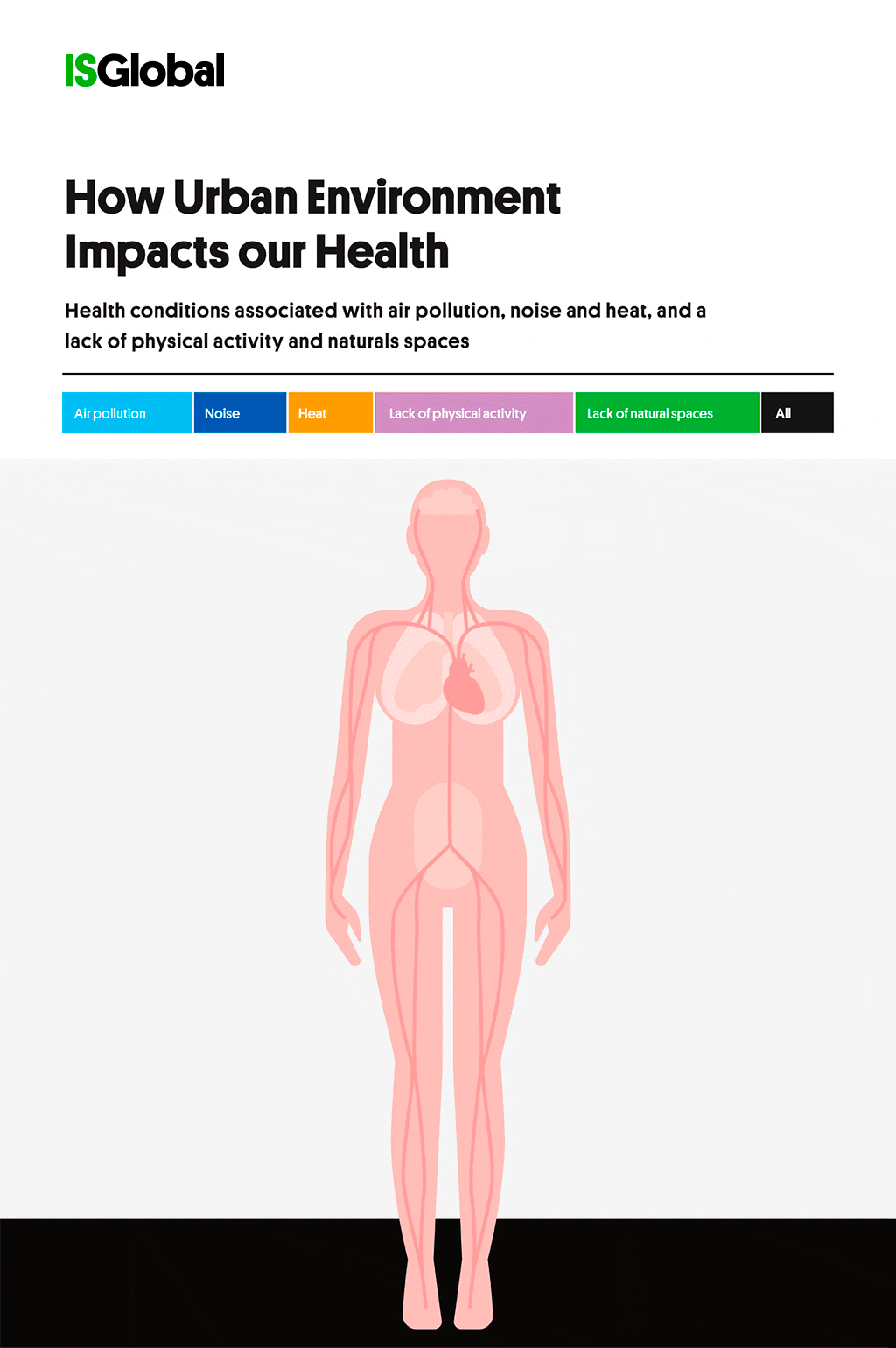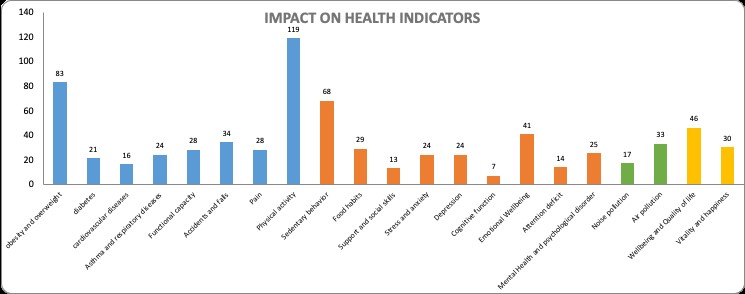HEALTHY CITIES: Bridging Urban Planning and Health
Edited on
02 February 2021WHY IT IS IMPORTANT TO PLAN AND DESIGN OUR CITIES FOR HEALTH
Almost all urban planning policies and actions have an impact on human health. Do you cycle or drive to work? Do you connect with your community or commute through it? And when you’re feeling stressed, is it easy to go for a calming stroll in a green space? All too often, when people hear health policy, they think hospitals. But health is holistic, with the design of our urban environment feeding into whether and how often populations need those hospitals. Urban planners select locations, design spaces, and place services, and there’s ample scientific evidence to indicate these factors have a big impact on health. ISGLOBAL has identified air pollution, noise, heat, and lack of physical activity or natural space as health hazards presented by city living (see figure 1). Good urban planning, however, can not only mitigate the impact of those hazards, but also become a tool for generating health.

When it comes to the design of an urban plan, policy or action, health is not always given the space it deserves in the conversation. Significantly, health experts are rarely involved in the development of urban plans and policies. Doctors, nurses and medical experts are generally fully occupied with patients, hospitals and the health system. There´s little room for involvement in urban planning. Unfortunately, our health systems are generally more reactive than proactive.

To take a proactive approach to health, city planners and policy makers should use Health Impact Assessments (HIAs) to better understand the impact of various urban factors on health. However, HIAs are often seen as an inessential add-on activity, rather than as a key preventative measure for improving overall health. On the other side, the lack of health-expert involvement in current HIA implementation hinders the effectiveness of their results.
HOW TO SYSTEMATICALLY INCLUDE HEALTH IN THE URBAN PLANNING, THE HEALTHY CITIES APPROACH
HEALTHY CITIES, a network of nine partners (local and planning authorities), is designing integrated action plans that bridge urban planning and health. Through its methodology the network aims to make urban planning a generator for health.
The network promotes health via a cross-sectoral and collaborative approach with the assistance of traditional health systems and experts (where possible). Physical, social and environmental health is a unifying objective for all the partners and a common thread for all the urban policies. Each partner has established a multidisciplinary local group to plan and design their urban areas. The groups consider all different stakes on the space, and involve environment experts, architects, health experts and people from citizens’ groups.
Figure 1. Health conditions associated with air pollution, noise and heat, and lack of physical activity and natural spaces. Source: ISGLOBAL: Urban Planning, Environment and Health Initiative, online HERE.
The network uses the HIA tool as a guide to understand the impact of urban determinants on health indicators. It also supports the Health in all Policies (HiaP) approach and uses its own Healthy Cities Assessment Tool for the best possible outcome.
Health Impact Assessment as an integrated tool
What is a Health Impact Assessment?
“Health Impact Assessment is a combination of procedures, methods and tools by which a policy, program or project may be judged as to its potential effects on the health of a population, and the distribution of those effects within the population” (WHO 1999). |
HIA is not a new tool. The first guidelines were developed back in the early 1990s, and in 1999 the Gothenburg consensus paper defined its main concepts and approaches. The HIA has six steps: Screening, Scoping, Assessment, Recommendations, Reporting and Monitoring & Evaluation (explained in figure 2).

Figure 2. The six steps of a HIA
Unfortunately, HIA is not mainstream practice in urban planning. Although it adds a layer of complexity to the planning process, it is a valuable and flexible tool that can adjust to fit the needs and expertise of its users. As a practice, HIAs aim to produce a set of evidence-based recommendations which maximise positive and minimise negative health impacts. These are used to inform decision-makers and the public when policies or plans with significant potential to impact health are being considered.
HIA is best implemented when its users also support the Health in All Policies (HiAP) approach. HiAP considers health implications systematically across sectors, ensuring governments commit to improving health and well-being. HiAP makes health a central pillar across different agencies and sectors, supporting collaboration with its evidence-based method. Adopting the HiAP principle can help make urban planning a generator of health.
What is novel in HEALTHY CITIES?
HEALTHY CITIES supports the HiAP practice and uses HIA for an integrated approach to urban planning practices. During the development of the nine local integrated action plans, health and urban planning inputs are both considered constantly (figure 3).

Even from the very first step of defining the objectives, the partners used the Healthy Cities Assessment Tool to evaluate and visualize the impact of all the proposed actions on health (figure 4).
The Healthy Cities Assessment Tool allows for a quick assessment of urban plans, objectives, and actions according to their influence upon the 16 urban determinates. It automatically calculates the potential health impact of actions, supporting decision making processes and demonstrating the health implications of urban planning decisions. It imparts knowledge to non-health experts and facilitates cross-disciplinary conversations. The influence of urban determinants on health can be direct (on some indicators such as cardiovascular diseases, respiratory diseases, diabetes, depression, etc.) or indirect (on some health determinants such as physical activity, food habits, air quality or noise pollution).
The Healthy Cities Assessment Tool (2020) is based on systematic review that aggregates scientific peer-reviewed publications linking urban determinants and their impact on urban health¹. The tool uses a matrix of 16 urban determinates and their impact on 21 health indicators. The tool has been developed by the coordinator of HEALTHY CITIES Marta Rofin Serra, urban planner and architect. |

Figure 4. The collective positive impact of the Integrated Action Plans’ objectives from the HEALTHY CITIES network. Top three positive health impacts: Physical activity, Obesity and overweight and Sedentary behaviour.
The HEALTHY CITIES methodology integrates a systematic analysis where each defined step of HIA supports three iterative elements: Analysis, Planning and Design and Governance ² (figure 5).
Analysis | It aims to establish facts and to analyse, define or reframe and address problems |
Planning and design | It aims to create images and to develop, analyse, discuss and propose solutions and strategies |
Governance | It involves participants in discussing and defining their ambitions to create socially construed knowledge and highlight the ambitions and roles of the stakeholders regarding the development project and policy in general |
This approach combines the HIA with the Framework for Collaborative Planning. The three elements are needed to appropriately and orderly address urban planning related issues and move from a challenge, to a design outcome through a collaborative approach. Essentially, this approach organises the HIA to better fit the purpose of urban planning.

Figure 5. The HIA steps combined with the Framework for Collaborative Planning
What is next?
The integrated approach proposed by HEALTHY CITIES is intended not to determine, but to support better decision-making in the development of integrated action plans. All tools and approaches will be further discussed and tested by the nine partners. As the project evolves more outcomes will be published related to the integrated approach and its effectiveness on how to plan and design for a healthier city. The goal of the network is to make urban planning a generator for health.
¹ Puig-Ribera A, Bort-Roig J, Rofin M, Garcia-Cuyás F, Geli M, Chamorro C, Perona-Ribes L, Cervantes P, Torrentó J, del Val R, Palmero F. (2018). Planning local urban environments to promote health in Vic (Barcelona): A comprehensive approach. European Journal of Public Health; 28 (suppl. 4): 208.
² van Herk S., Zevenbergen C., Ashley R., Rijke J.,Learning and Action Alliances for the integration of flood risk management into urban planning: a new framework from empirical evidence from The Netherlands,Environmental Science & Policy,Volume 14, Issue 5,2011.
Authors:
Sofia Aivalioti (HEALHTY CITIES Ad hoc Expert),
Marta Rofin Serra (HEALHTY CITIES coordinator),
Sebastiaan van Herk (HEALHTY CITIES Lead Expert)
 Submitted by Marta Rofin-Serra on
Submitted by Marta Rofin-Serra on
